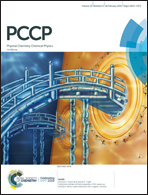Visible photodissociation of the CO2 dimer cation: fast and slow dissociation dynamics in the excited state†
Abstract
Velocity and angular distributions of photofragment CO2+ ions produced from mass-selected (CO2)2+ at 532 nm excitation were observed in an ion imaging experiment. The velocity distribution was assigned to two components, fast and slow velocity components, which was consistent with the previous study by Bowers et al. The anisotropy parameters of the angular distributions for the fast and slow velocity components were experimentally determined to be βfast = 1.52 ± 0.14 and βslow = 0.46 ± 0.10, respectively. In the theoretical approach, potential energy surfaces (PESs) of (CO2)2+ were calculated along two coordinates, the intermolecular distance and mutual orientations of the CO2 monomers. In addition, molecular dynamics simulations were performed. The visible transition of the most stable staggered structure of (CO2)2+ was attributed to ![[C with combining tilde]](https://www.rsc.org/images/entities/char_0043_0303.gif) 2Ag ←
2Ag ← ![[X with combining tilde]](https://www.rsc.org/images/entities/char_0058_0303.gif) 2Bu by an excited state calculation. On the PES of the
2Bu by an excited state calculation. On the PES of the ![[C with combining tilde]](https://www.rsc.org/images/entities/char_0043_0303.gif) state, a potential well was found in which the two CO2 monomers lay side by side to each other, in addition to a repulsive slope along the intermolecular distance. The results of the simulations confirmed that the fragment CO2+ ions with fast velocity and large anisotropy originated from the rapid dissociation of (CO2)2+ on the repulsive slope. Meanwhile, the fragment CO2+ ions with slow velocity and small anisotropy were expected to emerge from statistical dissociation after large amplitude libration of CO2 molecules which was caused by the potential well in the excited state PES.
state, a potential well was found in which the two CO2 monomers lay side by side to each other, in addition to a repulsive slope along the intermolecular distance. The results of the simulations confirmed that the fragment CO2+ ions with fast velocity and large anisotropy originated from the rapid dissociation of (CO2)2+ on the repulsive slope. Meanwhile, the fragment CO2+ ions with slow velocity and small anisotropy were expected to emerge from statistical dissociation after large amplitude libration of CO2 molecules which was caused by the potential well in the excited state PES.



 Please wait while we load your content...
Please wait while we load your content...